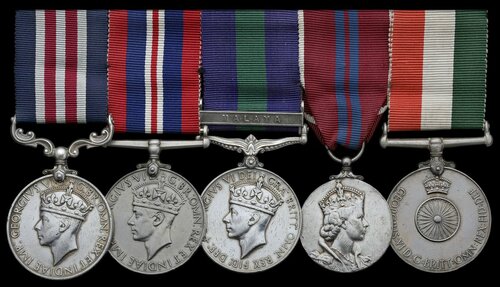
Auction: 21003 - Orders, Decorations and Medals
Lot: 526
A very fine immediate 'Ferret Force' Malaya M.M. group of five awarded to Sergeant Kambersing Rai, 7th Duke of Edinburgh's Own Gurkha Rifles
Military Medal, G.VI.R. (21138230 L.Cpl. Kambersing Rai. Gurkha Rif.); War Medal 1939-45; General Service 1918-62, 1 clasp, Malaya (21138230 Rfn. Khambasing Rai. M.M. 7 G.R.); Coronation 1953; Indian Independence 1947 (21138230 Rfn. Kambersing. Rai. M.M. G.R.), mounted as worn, some edge wear from contact, very fine (5)
M.M. London Gazette 4 February 1949. The original recommendation, which includes the remark of the Commander-in-Chief for it to be an Immediate award - states:
'Whilst serving with the 1/7GR Team of No 4 Group FORCE FERRET this NCO was engaged almost continuously on operations in the KLUANG and MUAR Districts of JOHORE from August to November 1948.
On one occasion in the PALOH area, whilst scouting ahead of a 4 man recce patrol, he encountered 11 armed bandits in a deserted squatter area. The bandits, whose arms included a Bren and a Thompson Sub machine gun, immediately opened fire.
Although alone, in the open and under intense automatic fire Kambersing immediately attacked the enemy without waiting for his patrol to come up to his assistance. Firing his Sten gun from the waist he shot dead one bandit, wounded another and routed the remainder, who in their flight, abandoned a T.S.M.G, 170 rounds of T.S.M.G. ammunition, a large quantity of equipment, rations and medical stores and a collection of documents subsequently found to be among the most important captured in the anti-bandit Campaign. This action took place on the 2 Oct 48.
Throughout the operations from August to November and in a number of engagements Kambersing displayed complete disregard for danger, a great offensive spirit and a desire to get to grips with the enemy and the initiative and skill unusual in so young and junior N.C.O.'
Kambersing Rai enlisted in the Indian Army on 29 November 1943 and transferred to the British Army on 1 January 1948 whilst serving with the 1st Battalion in Rangoon. Having been promoted Lance-Corporal in June 1948, he served a tour with Ferret Force. That unit was formed of volunteers from British, Gurkha and Malay Battalions, Chinese interpreters and liaison Officers and Dyak and Iban trackers from Sarawak, all led by former Officers from the Special Operation Executive's Force 136. Their task was to seek out the enemy, in order that they be brought to battle by the main forces. With the disbandment of the Special Air Service, Ferret Force were rightly considered the elite force in these operations. Four groups were formed, each group being four 15-man teams. Operating deep in the jungle, they lived off the land and had an array of successes, no less than the examples mentioned in the above citation. Major Richards, seconded to the 7th Gurkhas, gave insight in The Kukri - Journal of the Brigade of Gurkhas regarding their operations during Operation 'Rugger':
'An area of approximately 200 square miles, largely hill jungle, was to be our playground and initially, no other troops were to operate in this area....We slipped into the jungle before first light and, avoiding paths, moved east, until a suitable base was found.'
The Force were to begin their operation by destroying enemy camps and disrupting their lines of supply and communication. After some 14 days of being drained by leeches and harassed the enemy, including a number of costly engagements, Phase 2 was to begin after returing to the Rear HQ. A larger attack on the squatter bandit camp in the 23rd Mile Village area. Sweeping in, the Ferret Force, with support from the Seaforths and the 2nd Gurkhas, several bandits were killed in the first forays, whilst the remainder of those in the village were checked, with the help of the interpreters. By nightfall some 80 bandits had been shaken down and arrested. The village was burnt, much to the pleasure of the local Planters and workers, who knew that it was the centre for local Communist activity. Ferret Force were moved out to Port Dickson some days later and disbanded. So closed this chapter on the Malaya campaign. The lessons learnt however surely led to the re-forming of the SAS.
Kambersing Rai was awarded one of the first eight M.M.s for the campaign, four of which went to Gurkhas.
Following his time with the Ferret Force, Kambersing Rai served with the Boys Training Company for several months, before being part of the Coronation Contingent in 1953 (The Kukri, refers). Promoted Sergeant in 1958, he was discharged in December 1961; sold together with a file of research.
Subject to 20% VAT on Buyer’s Premium. For more information please view Terms and Conditions for Buyers.
Sold for
£7,000
Starting price
£1600




